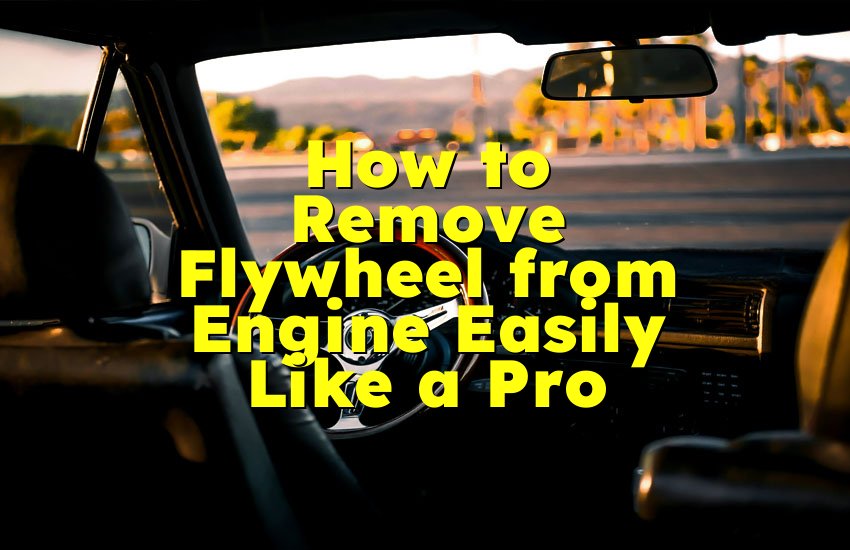As an Amazon Associate, I earn from qualifying purchases at no extra cost to you.
How to Remove Torque Converter from Flywheel Easily at Home
One afternoon, my friend called, frustrated because his car wouldn't move even after changing the transmission fluid. Turns out, the torque converter was stuck to the flywheel. He had no clue what to do next. I remember thinking, many DIYers face the same issue but don't know where to start. Removing a torque converter might sound tough, but with patience and a few right moves, it's totally doable.
To remove a torque converter from a flywheel, first disconnect the battery and safely lift the car. Then, drain transmission fluid before detaching the driveshaft. Next, unbolt the transmission and support it firmly with a jack. Remove the converter bolts carefully and slide the converter away from the flywheel. Finally, inspect the converter and flywheel for wear or cracks before reinstalling or replacing parts.
Prepare the Car and Work Area
Before touching anything under the hood, safety should come first. I remember when I tried my first torque converter removal, I underestimated how heavy transmissions could be. So, always begin by parking the vehicle on level ground and engaging the parking brake. Make sure to disconnect the negative battery cable to avoid any electrical accidents while working. A small spark under the car is the last thing you want to see.
Next, lift the vehicle using a reliable hydraulic jack and secure it with sturdy jack stands. I once saw a guy rely only on a jack, and it slipped—luckily, no one got hurt, but it was a good reminder. Once lifted, slide under the vehicle and locate the transmission area. You'll also want to gather tools like socket wrenches, a drip pan, and a transmission jack if possible.
Then, drain the transmission fluid. Place a pan under the transmission and loosen the drain plug carefully. The fluid can be hot, so let the car cool for a bit before doing this. Once drained, replace the plug temporarily to prevent dripping while you continue. Wipe any spills immediately to avoid a slippery mess.
Lastly, remove the driveshaft if your vehicle has rear-wheel drive. It's usually connected with bolts at both ends. Mark its position before removing it to ensure proper alignment later. Once done, you'll have clear access to the transmission and torque converter area, ready for the next phase.
- Always secure your car with jack stands.
- Drain the transmission fluid before removing any parts.
- Label bolts and connections for easier reassembly.
Detach the Transmission Safely
Now that everything's accessible, it's time to disconnect the transmission. This part can be tricky because of the weight and tight bolts. Before doing anything, place a transmission jack under it for support. You don't want that heavy metal piece suddenly dropping while you're loosening bolts—it can seriously hurt you.
Start by removing any wiring harnesses or connectors attached to the transmission. These include sensors and shift linkages. It's easy to forget one hidden connector, so double-check all sides before pulling anything. Keep a small box handy for storing bolts so nothing goes missing. You'll thank yourself later during reassembly.
Next, remove the transmission mounting bolts connecting it to the engine. It's best to loosen them gradually in a crisscross pattern to reduce stress on the parts. As you do, you may feel the transmission start to shift slightly. That's where the jack comes in handy—adjust it slowly to balance the weight evenly.
When the bolts are completely out, gently separate the transmission from the engine. Wiggle it slightly to help release any tight spots. Never use force or pry too hard; it can damage the bell housing or torque converter. Once the gap opens up, you'll finally see the torque converter attached to the flywheel, ready for removal.
- Use a transmission jack to prevent injuries.
- Label electrical connectors for quick reinstallation.
- Loosen bolts in a balanced order to reduce pressure.
Locate and Inspect the Torque Converter
At this point, you'll be looking directly at the torque converter. It's the circular metal component sitting snugly against the flywheel. I remember the first time I saw it, I thought it looked like a big steel donut. But it plays a serious role in transferring power from the engine to the transmission. Before removing it, take a moment to inspect the area carefully.
Shine a flashlight into the bell housing and check for any leaks or metal shavings. These could point to deeper issues like worn seals or internal damage. Spin the converter slightly to see if it moves freely. If it's stuck, don't panic—it's usually just seated tightly against the flywheel. A gentle wiggle often loosens it enough for the next step.
Look for the bolts connecting the converter to the flywheel. Depending on your car, there may be three or four bolts holding it in place. You'll likely need to rotate the crankshaft using a socket on the crank pulley bolt to access each one. It's a slow process, but patience here prevents stripped threads or broken bolts.
If the converter looks damaged—say, it's dented or leaking fluid—make a note to replace it. Running a bad converter can cause slipping or vibration once reinstalled. Checking this now saves a lot of trouble later. Take your time to ensure everything's ready before moving forward.
- Inspect for leaks or worn spots before removal.
- Rotate the crankshaft to access all converter bolts.
- Replace damaged torque converters immediately.
Unbolt the Converter from the Flywheel
Here's where most people get nervous, but it's not as hard as it sounds. Start by securing the flywheel from turning while you loosen the converter bolts. You can wedge a screwdriver between the teeth of the flywheel and the housing to keep it still. It doesn't need to be jammed hard—just enough to prevent movement.
Using a socket wrench, carefully loosen one bolt at a time. Turn the crankshaft slightly to bring the next bolt into view. You'll likely need to repeat this three or four times until all bolts are out. It's important not to rush because the bolts are often tight and in awkward positions. If one feels stuck, spray a bit of penetrating oil and wait a few minutes.
Once the bolts are out, the converter will still sit flush against the flywheel. Gently pull it backward, wiggling it side to side until it separates. Avoid pulling too hard or fast—it should slide off smoothly once it's free. You'll notice a bit of transmission fluid dripping as it comes loose, so keep a rag handy to catch any spills.
Check the bolt holes and threads for any damage. If they're stripped, repair them before reinstalling to avoid future trouble. It's these little checks that make your work more reliable in the long run. Once it's free, set the converter aside carefully.
- Rotate crankshaft for each bolt access point.
- Don't over-force tight bolts—use oil instead.
- Support converter when sliding it off to prevent spills.
Separate the Converter and Inspect Flywheel Condition
With the torque converter removed, it's time to take a closer look at the flywheel. This step often gets skipped, but it's one of the most important checks in the process. The flywheel faces intense heat and friction, so any cracks or warping could lead to vibration or transmission noise later on.
Use a flashlight and run your hand lightly across the flywheel surface. Feel for grooves, uneven spots, or burns. If you spot blue discoloration, that means overheating. I once ignored that sign, and within months, the car started shaking during acceleration. Lesson learned—inspect carefully now to avoid pulling the transmission again later.
Also, check the bolt holes where the torque converter was attached. They should be tight and undamaged. Loose holes can cause rattling or even converter misalignment. If you find any cracks, it's safer to replace the flywheel entirely rather than trying to patch it. It's a crucial part, so don't cut corners here.
Finally, clean off any dirt or oil residue using a lint-free cloth and brake cleaner. This ensures a strong connection when reinstalling. Once you're satisfied everything looks good, you can prepare for reassembly or replace parts as needed.
- Inspect flywheel for cracks or burns.
- Replace damaged flywheels immediately.
- Clean surface before reinstallation.
Reinstall Components and Test Smooth Operation
Once you're confident with your inspection, start reassembling everything in reverse order. Begin by carefully sliding the torque converter back onto the transmission input shaft. Turn it slowly until you feel it seat properly—usually, it clicks or slides in three stages. If it doesn't seat fully, don't force it, or you risk damaging the pump inside.
Next, align the transmission with the engine. Move it gently toward the flywheel until the converter sits flush against it. Insert the mounting bolts loosely first to hold everything in place, then tighten them gradually in a balanced pattern. Once it's secure, reattach the converter bolts through the access holes and torque them to the manufacturer's specs.
Reconnect all electrical connectors, linkages, and the driveshaft. Refill the transmission with the recommended fluid and check for any leaks. Lower the car carefully and reconnect the battery. Now comes the rewarding part—start the engine and shift through the gears to test smooth operation.
If everything feels steady and there's no unusual vibration, you've successfully removed and reinstalled your torque converter. It's a satisfying job, especially knowing you did it safely and correctly with your own hands.
- Seat the converter properly before tightening bolts.
- Always refill transmission fluid after reinstallation.
- Test drive gently to confirm smooth shifting.
Final Thoughts
Removing a torque converter from a flywheel might seem complex, but with patience and attention, it's entirely possible to do at home. Taking your time, labeling parts, and keeping things clean makes a huge difference. Once you finish and hear that smooth gear engagement again, you'll feel proud of the effort—and a lot more confident for your next repair.
| Task | Tool Needed | Helpful Tip |
|---|---|---|
| Disconnect battery | Wrench | Prevent accidental sparks |
| Lift vehicle | Hydraulic jack + stands | Always secure both sides |
| Drain transmission fluid | Socket & drain pan | Let engine cool first |
| Remove driveshaft | Socket wrench | Mark alignment before removal |
| Unbolt transmission | Transmission jack | Loosen bolts evenly |
| Remove converter bolts | Socket wrench | Rotate crankshaft for access |
| Inspect flywheel | Flashlight | Check for cracks or heat spots |
| Refill transmission | Funnel & fluid | Use correct fluid type |
Frequently Asked Questions (FAQs)
Is it hard to remove a torque converter from a flywheel?
It's not exactly hard, but it requires patience and safety. The biggest challenge is handling the transmission's weight and reaching tight bolts. Using a transmission jack and labeling everything makes it much easier. Take your time, work slowly, and make sure the car is secure before crawling underneath. That's what makes the process smooth and safe.
Can I remove a torque converter without removing the transmission?
Not really. The converter sits between the transmission and the flywheel, so the transmission has to be moved away to access it. You can't slide it out otherwise. It's like trying to pull a plate from under another one—it just won't work. So, plan to drop or slide the transmission back slightly for full access.
Do I need special tools to remove the torque converter?
You'll need basic mechanic tools like socket wrenches, a transmission jack, and a drain pan. Some vehicles may need a crankshaft turning tool to rotate the flywheel. Having these ready makes your job safer and faster. You don't need expensive tools, just reliable ones that fit well and don't slip.
Is it normal for fluid to leak when removing the torque converter?
Yes, a small amount of transmission fluid usually drips out when you remove the converter. That's completely normal. Keep a pan underneath to catch it. However, if a lot of fluid pours out, check the transmission seal—it may need replacing before reinstalling everything.
Can I reuse my old torque converter?
You can if it's still in good condition, but always inspect it carefully first. Look for dents, leaks, or burnt fluid smells. A worn converter can cause poor shifting or vibrations later. Sometimes, replacing it during transmission service saves time and avoids future problems.
Do I need to replace the transmission fluid after removal?
Yes, definitely. When you remove the converter, a good portion of fluid drains out. It's best to refill with fresh fluid to maintain smooth gear operation. Old fluid can cause slipping or overheating, so always top up or replace it completely after reassembly.
Is it okay to clean the torque converter before reinstalling?
Yes, you can clean the exterior with brake cleaner or a degreaser. But never open or flush it unless you're a professional. Just wipe off dirt and oil so it fits snugly against the flywheel again. A clean surface prevents slippage and ensures proper alignment.
Do I need to torque the converter bolts to a specific setting?
Absolutely. Each vehicle has a specific torque spec for converter bolts—usually around 30–40 ft-lbs. Check your repair manual for the exact figure. Tightening them evenly prevents imbalance or wobble during operation. A torque wrench is the safest way to get it right.











